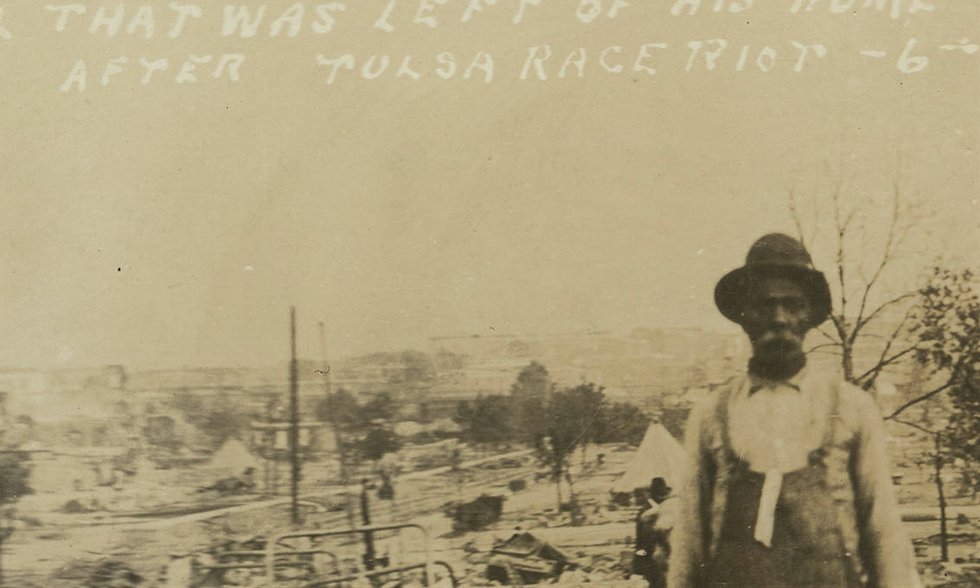By David Jordan Jr
Less than sixty years after the ending of slavery in the United States of America, the most prominent and wealthiest community of Black People existed and thrived in Tulsa, Oklahoma. Greenwood, Oklahoma (referenced as Black Wall Street) was home to a distinct community of Black people that journeyed to Oklahoma with the idea of self-sufficiency, self-pride, excellence, and most importantly the resources to build an affluent community that thrived on unison in all aspects. During a time when segregation and Jim Crow laws stifled the advancement of Black people post-slavery, Greenwood, Oklahoma became a city that Black people not only built for themselves but also one of many rich Black communities that were present in various states across post Civil War America.
During a time when segregation and Jim Crow laws stifled the advancement of Black people post-slavery, Greenwood, Oklahoma became a city that Black people not only built for themselves but also one of many rich Black communities that were present in various states across post Civil War America.
Black Wall Street (also termed “Negro Wall Street” by Booker T. Washington ) was essentially the brainchild of O.W. Gurley, a man that understood the power of land ownership and spearheaded the continued migration of Black people from the deep south to Oklahoma. The affluency within this community was resented by poor White people in surrounding communities, something that would fuel the tension which led to the destruction of Black Wall Street on the dates of May 31st and June 1st 1921. Many businesses prospered in the town of Greenwood; doctors, lawyers, bankers, barbers, dentists, journalists ( A. J. Smitherman founded Tulsa Star), and several other independent entrepreneurs that provided specialized services.
The affluency within this community was resented by poor White people in surrounding communities, something that would fuel the tension which led to the destruction of Black Wall Street on the dates of May 31st and June 1st 1921. Many businesses prospered in the town of Greenwood; doctors, lawyers, bankers, barbers, dentists, journalists ( A. J. Smitherman founded Tulsa Star), and several other independent entrepreneurs that provided specialized services.  Home and businesses within the town also had indoor plumbing, which was a rarity for many homes and businesses at the time. J.B. Stradford, founded and opened Stradford Hotel at 301 Greenwood Avenue in 1918. The Stradford Hotel contained fifty-four rooms and was one of the nicest hotels in the country for Black citizens.
Home and businesses within the town also had indoor plumbing, which was a rarity for many homes and businesses at the time. J.B. Stradford, founded and opened Stradford Hotel at 301 Greenwood Avenue in 1918. The Stradford Hotel contained fifty-four rooms and was one of the nicest hotels in the country for Black citizens.
Spanning thirty-five blocks, the community of Greenwood was able to flourish due to its retainment of the money made within the community. The dollar circulated thirty-six to one hundred times and did not leave the community for at least a year.

 The building of financial wealth and the abundance of business made Greenwood a resource for not only its community but also for White businesses in surrounding areas, as those businesses would come to Greenwood to borrow money from the Black banks. The state of Oklahoma contained two airports, yet there were six airplanes owned by six different black families in Greenwood, Oklahoma, another fact that caused resentment among White citizens in nearby areas. Many of the citizens of Greenwood never had interactions with White citizens due to everything being readily available and efficient in their community.
The building of financial wealth and the abundance of business made Greenwood a resource for not only its community but also for White businesses in surrounding areas, as those businesses would come to Greenwood to borrow money from the Black banks. The state of Oklahoma contained two airports, yet there were six airplanes owned by six different black families in Greenwood, Oklahoma, another fact that caused resentment among White citizens in nearby areas. Many of the citizens of Greenwood never had interactions with White citizens due to everything being readily available and efficient in their community. White citizens would come sell products to Black business owners but that was the extent of their interactions. The foundation for the eventual Tulsa Race Riot was essentially laid by the Klu Klax Klan, which was prominent in the state of Oklahoma and also had many of its members in positions of leadership in the state and city legislature. Another fact that caused resentment was the land on which Black Wall Street was built; oil, very prominent within the region, was plentiful in the land which these Black business owners owned. Prior to the Massacre, a Black man was arrested for a minor offense and the Klan came to the jail, took him out of his cell, tying a noose around his neck and tying him to a car, and lynching him, something that would prove to be a precursor for the Race Riot that would occur in the near future.
White citizens would come sell products to Black business owners but that was the extent of their interactions. The foundation for the eventual Tulsa Race Riot was essentially laid by the Klu Klax Klan, which was prominent in the state of Oklahoma and also had many of its members in positions of leadership in the state and city legislature. Another fact that caused resentment was the land on which Black Wall Street was built; oil, very prominent within the region, was plentiful in the land which these Black business owners owned. Prior to the Massacre, a Black man was arrested for a minor offense and the Klan came to the jail, took him out of his cell, tying a noose around his neck and tying him to a car, and lynching him, something that would prove to be a precursor for the Race Riot that would occur in the near future.
Similar to the horrific murder of Emmett Till, an instance occurred where a White woman screamed in an elevator in the presence of a Black man, which led to the Black man being arrested and furthermore not being released from jail on the night of May 31st, 1921. Crowds from both sides began to surround the jail and a skirmish between a Black man and a White man result in shots which started the beginning of the Tulsa Massacre. A town of ten thousand Black citizens, Black businesses, and Black-owned property would be destroyed over a twelve hour period, continuing into the next day, June 1st, 1921. As the massacre took place, authorities and legislative officials across the state were unaware. The fact that phone lines and telegraph lines were down made it impossible for information to be relayed in a quick manner, which in turn led to the total destruction of the town. Once the governor was aware of the riot, the Oklahoma National Guard was sent to Greenwood and MArtial LAw was enacted immediately. Those the National Guard was sent and compounds for Black people were set up, the totality of damage was done; the town, its businesses, and the homes of its citizens smoldered in complete ruins.




One of the worst after-effects of the massacre was the fact that insurance companies didn’t provide any money for its policyholders. Stating that the riot was “An Act Of God” provided the insurance companies an easy out to neglect the Black citizens that owned policies and were seeking relief. In 1921 there was no FDIC (Federal Deposit Insurance Corporation) so banks that had money lost everything. Jewelry and other pieces of personal property that were stolen in the looting wasn’t replaced nor acknowledged by the insurance companies. Money which was stored in a safe survived the massacre and was returned to the owners and was also used by its owner to travel the country to Black churches and detail what happened, as The E. W. Scripps Company decided not to report any of the event in its newspapers. The rebuilding of the community was met with newly created zoning laws which tried to prevent Black people from rebuilding on their own property unless they were building two-story homes. Black lawyers fought the zoning laws and were victorious, enabling the area to be rebuilt and flourish well into the 1950s.
The devastating effects of the aftermath of the Tulsa Massacre is continuous; Black people that had established businesses and owned property were brought to ruins by hatred, thus killing the forward momentum of generational wealth and more black businesses. The confiscating of the property, the loss of money, and the continuance of racism in that area created a permanent dead end to the most prolific and most affluent Black community in the history of the United States of America.
Check Out The Gallery Here



































